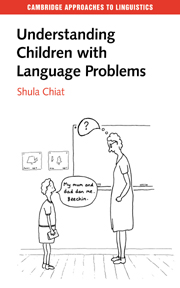Book contents
- Frontmatter
- Contents
- Acknowledgements
- Glossary of text conventions and symbols
- Introduction
- Part I Problems with words
- Part II Grappling with verb structure
- 7 Translating events
- 8 Growing verb structures
- 9 Shortfalls with verbs
- 10 ‘Thing out. Tip in there’: problems with verb processing
- Part III Missing function morphemes
- Part IV Hidden meanings, baffling meanings
- Endpoint and springboard
- Further reading
- References
- Index
7 - Translating events
Published online by Cambridge University Press: 05 September 2012
- Frontmatter
- Contents
- Acknowledgements
- Glossary of text conventions and symbols
- Introduction
- Part I Problems with words
- Part II Grappling with verb structure
- 7 Translating events
- 8 Growing verb structures
- 9 Shortfalls with verbs
- 10 ‘Thing out. Tip in there’: problems with verb processing
- Part III Missing function morphemes
- Part IV Hidden meanings, baffling meanings
- Endpoint and springboard
- Further reading
- References
- Index
Summary
When children are having difficulties with sentences, the most immediate sign of those difficulties will probably be the way they struggle in everyday conversations. They don't necessarily have problems taking turns as conversational partners. But as they take their turns, they falter, producing utterances which are halting, or limited, or mixed up. Witness Eamonn's attempts to explain that he has been unwell in the night and that his teacher may have to call his mother:
I not feel well today - sick the school - why - my mum gonna call - Mary gonna call me - Anna gonna call m - call my mummy I sick … I'm getting sick in school - Anna gonna t - phone - my mum out - phone my mummy out.
Here, we see Eamonn start a sentence, stall, have another go, or change direction and start again. Each stab he makes at expressing himself consists of a run of words which comes out fluently even though it may be incomplete. Other children produce sequences of words which may be clearer but are more disjointed. Take 8-year-old Richard's attempts to explain what happens to the lambs on the farm where he lives:
R: Um - girls, keep, boys, not keep.
SC: What do you do with the boys?
R: [tsεl - tsε-] on - oth’ people.
SC: Sell them? So why do you keep the girls?
R: Breeding.
A closer look at these children's utterances shows that some of them are organised in slightly odd ways. As well as leaving out certain words, they may combine words which don't go together, or which don't quite get across the meaning they seem to be aiming for, as with Eamonn's…
- Type
- Chapter
- Information
- Understanding Children with Language Problems , pp. 113 - 126Publisher: Cambridge University PressPrint publication year: 2000

